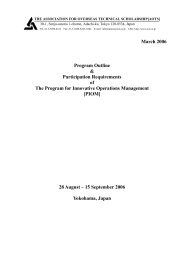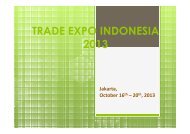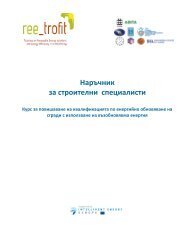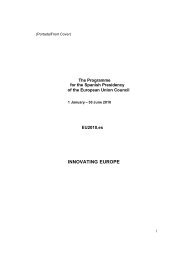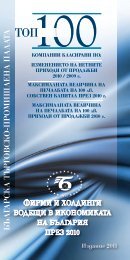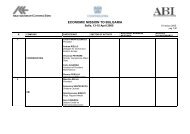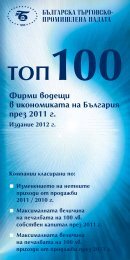Analysis of the Operation and Financial Condition of the Enterprise
Analysis of the Operation and Financial Condition of the Enterprise
Analysis of the Operation and Financial Condition of the Enterprise
You also want an ePaper? Increase the reach of your titles
YUMPU automatically turns print PDFs into web optimized ePapers that Google loves.
<strong>Analysis</strong> <strong>of</strong> <strong>the</strong> <strong>Operation</strong> <strong>and</strong> <strong>Financial</strong> <strong>Condition</strong> <strong>of</strong> <strong>the</strong> <strong>Enterprise</strong>period is made up <strong>of</strong> a capital <strong>of</strong> varying sizes which has accumulated over many years. Byusing <strong>the</strong> average value <strong>of</strong> <strong>the</strong> total capital we may compensate for this inconsistency.The higher <strong>the</strong> share <strong>of</strong> <strong>the</strong> equity capital in <strong>the</strong> total, <strong>the</strong> higher is <strong>the</strong> financialstability <strong>of</strong> an enterprise.Therefore, <strong>the</strong> next measure <strong>of</strong> financial pr<strong>of</strong>itability is <strong>the</strong> return on equity(ROE). This measure allows to identify <strong>the</strong> efficiency <strong>of</strong> use <strong>of</strong> <strong>the</strong> capital which has beeninvested by <strong>the</strong> enterprise owners. This ratio is calculated as follows:Return on own equityAnnual pr<strong>of</strong>it 100 % (4.30.)Own equityFrom <strong>the</strong> owners’ perspective this is <strong>the</strong> most important measure <strong>of</strong> return. Anyincrease in this ratio evidences an increase in <strong>the</strong> efficiency <strong>of</strong> employment <strong>of</strong> all forms <strong>of</strong>equity. This gives <strong>the</strong> opportunity to raise <strong>the</strong> level <strong>of</strong> dividend payout, to provide moreassets for investment. It should be noted that such a statement is only grounded if <strong>the</strong> share<strong>of</strong> equity in <strong>the</strong> financing <strong>of</strong> <strong>the</strong> assets is constant or increasing.The values <strong>of</strong> return on capital employed <strong>and</strong> return on equity are different. Thisis related to <strong>the</strong> use <strong>of</strong> <strong>the</strong> debt capital for which an enterprise should pay interest <strong>and</strong> <strong>the</strong>more <strong>the</strong> enterprise uses <strong>the</strong> borrowed capital, <strong>the</strong> larger is <strong>the</strong> amount <strong>of</strong> interest payable.In Table 4.1 a summary <strong>of</strong> <strong>the</strong> above discussed as well as o<strong>the</strong>r financial analysisratios (investment ratios). These ratios are used in performance <strong>of</strong> <strong>the</strong> express analysis.Table 4.1<strong>Financial</strong> performance ratiosReturn on net assets:Primary ratioPr<strong>of</strong>it or income before interest <strong>and</strong> tax / net assets*Secondary ratiosPr<strong>of</strong>it margin:- pr<strong>of</strong>it or income before interest <strong>and</strong> tax / amount <strong>of</strong>sales;Asset turnover:- amount <strong>of</strong> sales / net assetsThird level ratiosControl over revenues <strong>and</strong> costs:- gross pr<strong>of</strong>it / amount <strong>of</strong> sales;- variable costs / amount <strong>of</strong> sales;- fixed costs / amount <strong>of</strong> sales;Use <strong>of</strong> assets:- fixed assets / amount <strong>of</strong> sales;- working capital / amount <strong>of</strong> sales.<strong>Financial</strong> performance measuresLiquidityCurrent ratio:- current assets / current liabilities;Quick ratio or <strong>the</strong> ‘acid test ratio’: cash plus accountsreceivable / current liabilities.84



